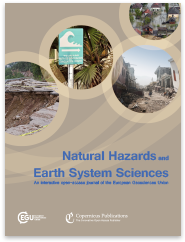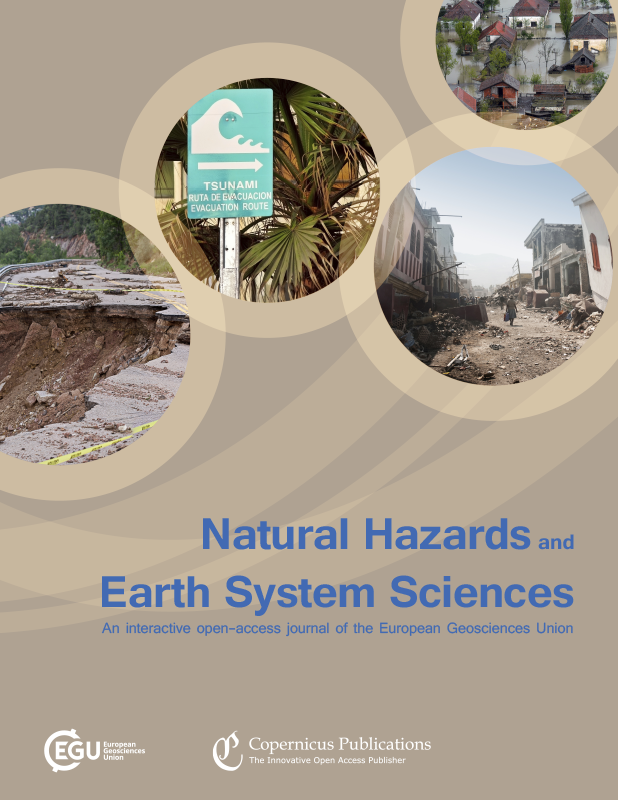Executive editors: Animesh Gain, Margreth Keiler, Gregor C. Leckebusch, Bruce D. Malamud, Paolo Tarolli & Uwe Ulbrich
eISSN: NHESS 1684-9981, NHESSD 2195-9269
Natural Hazards and Earth System Sciences (NHESS) is a not-for-profit interdisciplinary and international journal dedicated to the public discussion and open-access publication of high-quality studies and original research on natural hazards and their consequences. Embracing a holistic Earth system science approach, NHESS serves a wide and diverse community of research scientists, practitioners, and decision makers concerned with detection of natural hazards, monitoring and modelling, vulnerability and risk assessment, and the design and implementation of mitigation and adaptation strategies, including economical, societal, and educational aspects.
Journal metrics
NHESS is indexed in the Web of Science, Scopus, Google Scholar, etc. We refrain from displaying the journal metrics prominently on the landing page since citation metrics used in isolation do not describe importance, impact, or quality of a journal. However, these metrics can be found on the journal metrics page.
News
10 Feb 2025
Thank you to all our referees in 2024!
A big thank you to all referees for their volunteer work in providing fair, thorough, and constructive peer-review reports! Through their invaluable contribution our interactive open-access journals maintain their high scientific standards and their ongoing success. 
10 Feb 2025
Thank you to all our referees in 2024!
A big thank you to all referees for their volunteer work in providing fair, thorough, and constructive peer-review reports! Through their invaluable contribution our interactive open-access journals maintain their high scientific standards and their ongoing success. 
05 Feb 2025
Copernicus Publications and all journals left Twitter
The Copernicus Twitter account as well as all Twitter accounts of journals published by us have been deactivated. There will be no automatic feeds of newly posted preprints or published journal articles anymore, we do not actively tweet, and the status informs that the accounts are no longer maintained. Twitter is no longer linked from the journal websites or in the share section of the preprint or journal article HTML pages.
05 Feb 2025
Copernicus Publications and all journals left Twitter
The Copernicus Twitter account as well as all Twitter accounts of journals published by us have been deactivated. There will be no automatic feeds of newly posted preprints or published journal articles anymore, we do not actively tweet, and the status informs that the accounts are no longer maintained. Twitter is no longer linked from the journal websites or in the share section of the preprint or journal article HTML pages.
04 Jul 2025
Tree fall along railway lines: modelling the impact of wind and other meteorological factors
Rike Lorenz, Nico Becker, Barry Gardiner, Uwe Ulbrich, Marc Hanewinkel, and Benjamin Schmitz
Nat. Hazards Earth Syst. Sci., 25, 2179–2196, https://doi.org/10.5194/nhess-25-2179-2025,https://doi.org/10.5194/nhess-25-2179-2025, 2025
Short summary
04 Jul 2025
The first Earthquake Early Warning System for the high-speed railway in Italy: enhancing rapidness and operational efficiency during seismic events
Simona Colombelli, Aldo Zollo, Francesco Carotenuto, Alessandro Caruso, Luca Elia, Gaetano Festa, Sergio Gammaldi, Antonio Giovanni Iaccarino, Giovanni Iannaccone, Alberto Mauro, Matteo Picozzi, Giulia Polimanti, Rosario Riccio, Stefania Tarantino, Francesco Cirillo, Andrea Vecchi, and Franco Iacobini
EGUsphere, https://doi.org/10.5194/egusphere-2025-2668,https://doi.org/10.5194/egusphere-2025-2668, 2025
Preprint under review for NHESS (discussion: open, 0 comments)
Short summary
Highlight articles
23 Jun 2025
It could have been much worse: spatial counterfactuals of the July 2021 flood in the Ahr Valley, Germany
Sergiy Vorogushyn, Li Han, Heiko Apel, Viet Dung Nguyen, Björn Guse, Xiaoxiang Guan, Oldrich Rakovec, Husain Najafi, Luis Samaniego, and Bruno Merz
Nat. Hazards Earth Syst. Sci., 25, 2007–2029, https://doi.org/10.5194/nhess-25-2007-2025,https://doi.org/10.5194/nhess-25-2007-2025, 2025
Short summary
12 May 2025
Social sensing a volcanic eruption: application to Kīlauea, 2018
James Hickey, James Young, Michelle Spruce, Ravi Pandit, Hywel Williams, Rudy Arthur, Wendy Stovall, and Matthew Head
Nat. Hazards Earth Syst. Sci., 25, 1681–1696, https://doi.org/10.5194/nhess-25-1681-2025,https://doi.org/10.5194/nhess-25-1681-2025, 2025
Short summary
29 Apr 2025
Mapping vulnerability to climate change for spatial planning in the region of Stuttgart
Joanna M. McMillan, Franziska Göttsche, Joern Birkmann, Rainer Kapp, Corinna Schmidt, Britta Weisser, and Ali Jamshed
Nat. Hazards Earth Syst. Sci., 25, 1573–1596, https://doi.org/10.5194/nhess-25-1573-2025,https://doi.org/10.5194/nhess-25-1573-2025, 2025
Short summary
03 Apr 2025
Monitoring snow depth variations in an avalanche release area using low-cost lidar and optical sensors
Pia Ruttner, Annelies Voordendag, Thierry Hartmann, Julia Glaus, Andreas Wieser, and Yves Bühler
Nat. Hazards Earth Syst. Sci., 25, 1315–1330, https://doi.org/10.5194/nhess-25-1315-2025,https://doi.org/10.5194/nhess-25-1315-2025, 2025
Short summary
More highlight articles  All EGU highlight articles
All EGU highlight articles 
Notice on the current situation in Ukraine
To show our support for Ukraine, all fees for papers from authors (first or corresponding authors) affiliated to Ukrainian institutions are automatically waived, regardless if these papers are co-authored by scientists affiliated to Russian and/or Belarusian institutions. The only exception will be if the corresponding author or first contact (contractual partner of Copernicus) are from a Russian and/or Belarusian institution, in that case the APCs are not waived.
In accordance with current European restrictions, Copernicus Publications does not step into business relations with and issue APC-invoices (articles processing charges) to Russian and Belarusian institutions. The peer-review process and scientific exchange of our journals including preprint posting is not affected. However, these restrictions require that the first contact (contractual partner of Copernicus) has an affiliation and invoice address outside Russia or Belarus.





